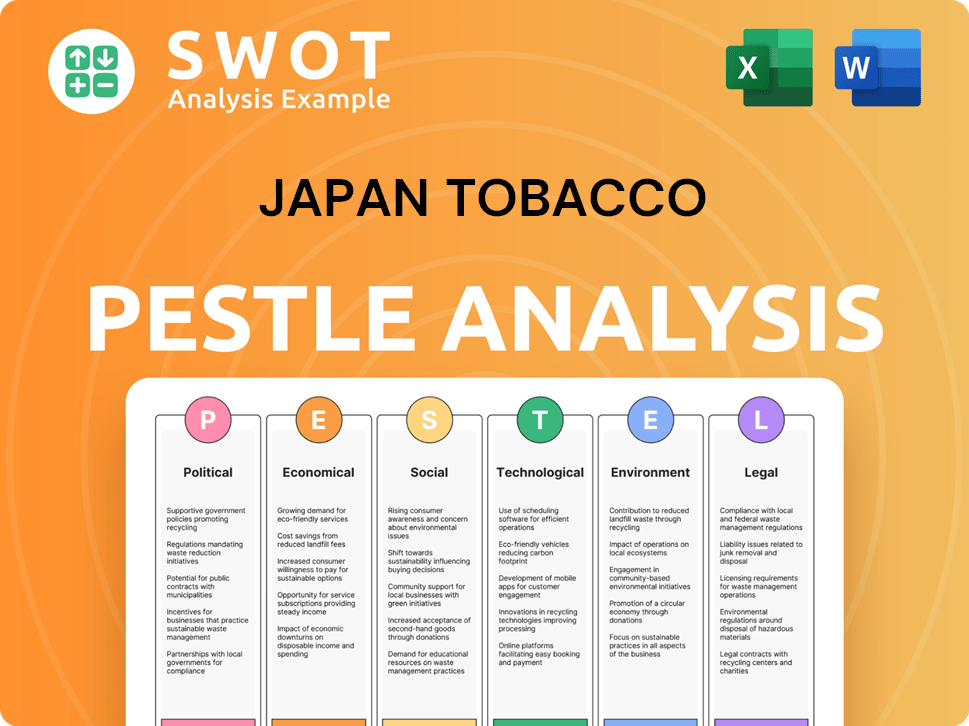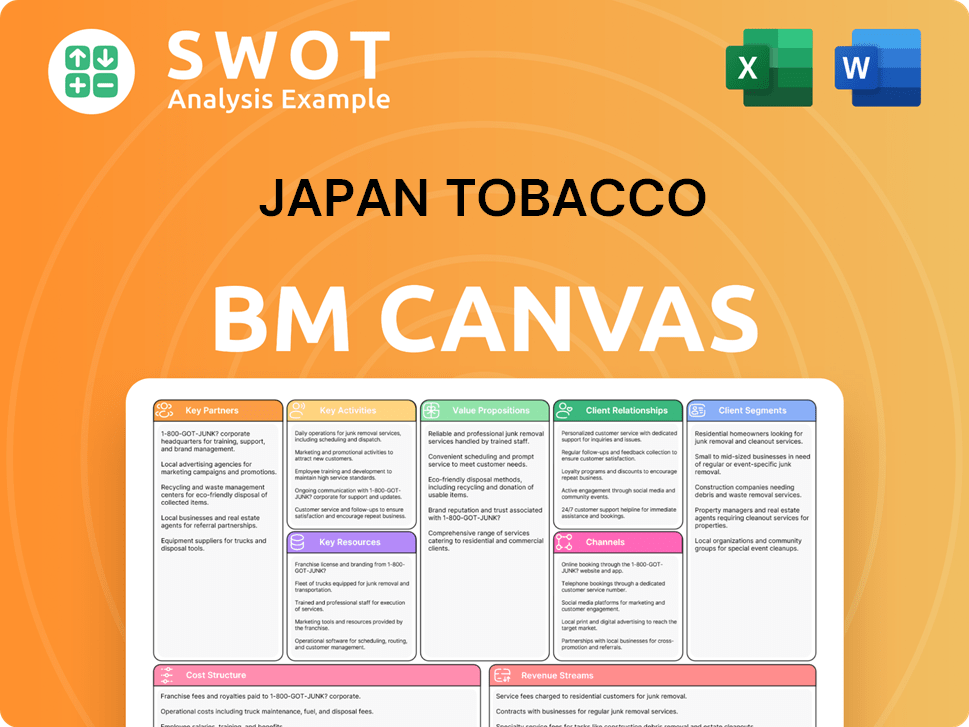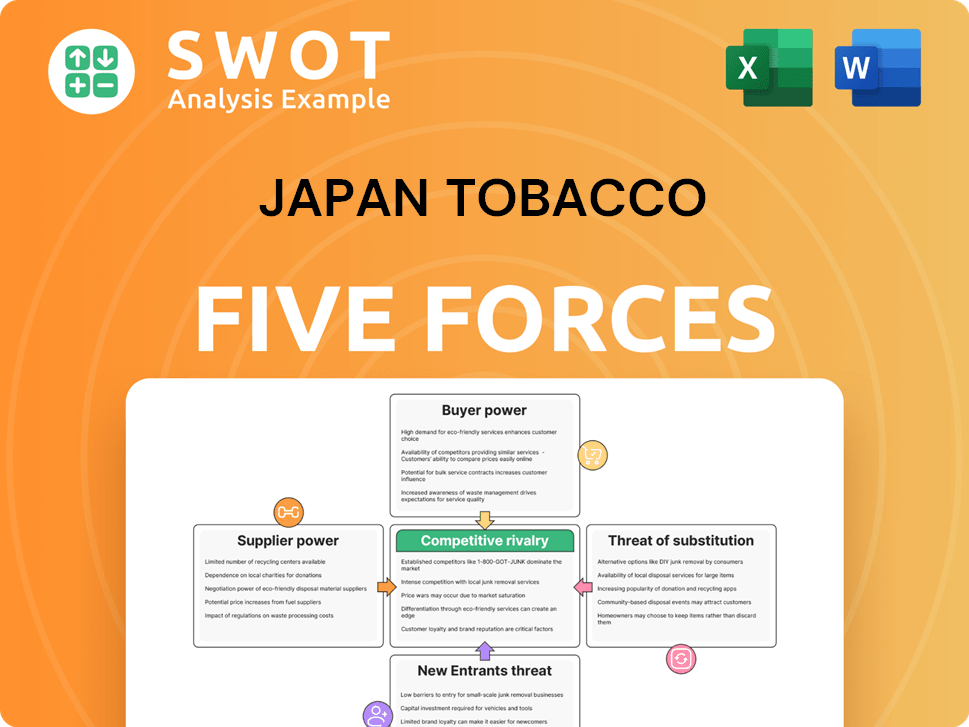Japan Tobacco Bundle
How did Japan Tobacco Company transform from a state monopoly to a global giant?
From its inception as a government-controlled entity in 1898, Japan Tobacco SWOT Analysis has undergone a remarkable transformation. Initially designed to centralize tobacco production and boost state revenue, the company's early years laid the foundation for its future international presence. This journey highlights key milestones and strategic shifts that have shaped the JT history and its impact on the Japanese tobacco industry.

This exploration of the Japan Tobacco Company will uncover the pivotal moments and strategic decisions that propelled JT Group to its current status. Understanding Japan Tobacco's evolution provides valuable insights into its adaptive strategies, including its privatization and international expansion. Discover the brief history of JT, from its monopolistic origins to its diversified global presence, examining its brands, acquisitions, and financial performance.
What is the Japan Tobacco Founding Story?
The story of the Japan Tobacco Company (JTC) begins on January 1, 1898. This pivotal date marks the establishment of the Japanese government's tobacco monopoly. This move was a strategic decision, driven by the need to secure stable tax revenues and exert control over the burgeoning tobacco industry.
The creation of this centralized entity was not the work of a single entrepreneur. Instead, it was a government initiative. This entity was responsible for all facets of tobacco production and sales within Japan. The primary issue addressed was the fragmented and unregulated nature of the tobacco market. This made efficient tax collection and quality control difficult.
The initial business model was a complete monopoly. The government exclusively held the rights to cultivate, manufacture, and sell tobacco products. This meant that existing private tobacco businesses were either absorbed or shut down. The early products included traditional Japanese tobacco varieties and cigarettes. These were produced under strict government oversight.
The establishment of the monopoly was deeply intertwined with the economic and political context of late 19th-century Japan. The nation was striving to modernize and strengthen its financial infrastructure.
- The government's expertise in administration and control, rather than entrepreneurial flair, defined the company's genesis.
- The government's actions were part of a broader effort to modernize and strengthen its financial infrastructure.
- The initial focus was on domestic production and distribution.
- The early years were characterized by strict government control over all aspects of the tobacco business.
The Japanese tobacco industry, under government control, focused on domestic production and distribution. This was essential for meeting the local demand. The government's approach was to ensure quality control and maximize tax revenue. This approach was a key element of the nation's economic strategy. For more insights into the company's ownership structure, you can explore Owners & Shareholders of Japan Tobacco.
In its early years, the company's financial performance was directly tied to the government's overall economic health. The monopoly structure ensured a steady stream of revenue for the state. This was crucial for funding various modernization projects. While specific financial figures from the late 19th century are difficult to compare with today's standards, the impact of the tobacco monopoly on the Japanese economy was significant. It provided a stable source of income and helped the government manage a critical industry.
Japan Tobacco SWOT Analysis
- Complete SWOT Breakdown
- Fully Customizable
- Editable in Excel & Word
- Professional Formatting
- Investor-Ready Format

What Drove the Early Growth of Japan Tobacco?
The early growth of Japan Tobacco Company, or JT, was marked by its position as a government monopoly. This gave the company exclusive control over the domestic market, allowing it to invest heavily in infrastructure. The initial focus was on launching various cigarette brands and traditional tobacco products to meet the needs of Japanese consumers. The company benefited from guaranteed sales, which helped it expand its manufacturing and distribution networks.
A significant turning point for the Target Market of Japan Tobacco came with the privatization of Japan Tobacco and Salt Public Corporation in 1985. This transition paved the way for international expansion and diversification beyond its core tobacco business. The acquisition of RJR International's non-US tobacco business in 1999 for approximately $7.8 billion was a pivotal move, substantially increasing its global presence and brand portfolio. This acquisition marked JT's entry into numerous new markets and established it as a major international player.
Further expansion was achieved through acquisitions, such as the purchase of Gallaher Group Plc in 2007 for approximately 7.5 billion pounds. These strategic moves allowed JT to gain market share in competitive international landscapes, diversifying its revenue streams. The company also began exploring new product categories, including pharmaceuticals and processed foods, as part of a broader diversification strategy to reduce reliance on the shrinking domestic Japanese market. In 2024, JT Group's revenue reached over ¥2.8 trillion.
Japan Tobacco PESTLE Analysis
- Covers All 6 PESTLE Categories
- No Research Needed – Save Hours of Work
- Built by Experts, Trusted by Consultants
- Instant Download, Ready to Use
- 100% Editable, Fully Customizable

What are the key Milestones in Japan Tobacco history?
The Japan Tobacco Company, or JT, has a rich history marked by significant milestones in the Japanese tobacco industry. From its beginnings as a state-owned entity to its global expansion, JT has navigated a complex landscape of regulations, market shifts, and technological advancements. The company's evolution reflects both its resilience and its strategic adaptation to the changing dynamics of the global tobacco market.
| Year | Milestone |
|---|---|
| 1904 | The predecessor of JT, the Monopoly Bureau, was established by the Japanese government, marking the beginning of state control over the tobacco industry. |
| 1949 | The Monopoly Bureau was reorganized as the Japan Tobacco and Salt Public Corporation, continuing state control and expanding its operations. |
| 1985 | The company was renamed Japan Tobacco Inc. (JT), reflecting a shift towards a more commercial structure. |
| 1994 | JT was partially privatized, with the government retaining a significant stake, setting the stage for further market-oriented strategies. |
| 1999 | The Japanese government fully privatized JT, marking a pivotal moment in its transformation into a global player. |
| 2007 | JT acquired Gallaher Group, significantly boosting its international presence and expanding its brand portfolio. |
| 2012 | JT entered the e-cigarette market with the launch of Ploom, demonstrating its commitment to innovation in reduced-risk products. |
| 2023 | JT reported a revenue of approximately ¥2.8 trillion (about $18 billion USD), reflecting its continued global presence and financial strength. |
Innovations have been a key aspect of the JT history. The company has invested heavily in research and development, particularly in reduced-risk products (RRPs), to meet evolving consumer preferences and regulatory demands. This includes the development of heated tobacco products like Ploom, which represent a significant shift in the Japanese tobacco industry.
JT has focused on developing and marketing heated tobacco products (HTPs) like Ploom, aiming to offer alternatives to traditional cigarettes. These products heat tobacco instead of burning it, potentially reducing harmful emissions.
JT has continually improved filter technology to enhance the smoking experience and reduce certain harmful substances. These advancements are crucial for product differentiation and consumer satisfaction.
JT invests in innovative product designs, including packaging and device aesthetics, to attract consumers and stay competitive. This includes efforts to create visually appealing and user-friendly products.
The company has invested significantly in RRPs, including heated tobacco and vaping products, to address changing consumer preferences and regulatory pressures. This is a key area for future growth.
JT holds numerous patents related to tobacco processing, filter technology, and product design, protecting its intellectual property and competitive advantages. This helps to secure its market position.
JT has focused on optimizing its global supply chain to improve efficiency and reduce costs, ensuring the timely delivery of products to various markets. This includes streamlining operations and logistics.
The JT Group faces several challenges. Declining smoking rates in many developed markets and stringent regulations worldwide impact the traditional tobacco business. Intense competition from global rivals also necessitates continuous innovation and strategic adaptation.
A significant challenge is the ongoing decline in smoking rates in many developed markets, which requires JT to diversify its product offerings and explore new revenue streams. This necessitates a proactive approach to market changes.
The tobacco industry faces increasingly stringent regulations, including restrictions on advertising, plain packaging, and higher taxes, which impact sales and profitability. JT must navigate complex regulatory environments globally.
JT faces intense competition from other major tobacco companies, requiring continuous innovation, effective marketing, and strategic acquisitions to maintain market share. The competitive landscape is constantly evolving.
Shifts in consumer behavior, such as the growing preference for reduced-risk products, demand that JT adapt its product portfolio and marketing strategies to stay relevant. This requires a flexible approach to market trends.
The need to diversify into pharmaceuticals and processed foods to mitigate risks associated with the tobacco industry presents both opportunities and challenges. JT must manage these new ventures strategically.
JT faces the ongoing challenge of balancing traditional tobacco sales with the development and promotion of next-generation products, requiring careful resource allocation and strategic decision-making. This dual focus is critical for long-term sustainability.
Japan Tobacco Business Model Canvas
- Complete 9-Block Business Model Canvas
- Effortlessly Communicate Your Business Strategy
- Investor-Ready BMC Format
- 100% Editable and Customizable
- Clear and Structured Layout

What is the Timeline of Key Events for Japan Tobacco?
The Japan Tobacco Company, or JT, has a rich history marked by significant milestones. From its origins as a government monopoly to its current status as a global tobacco giant, the company's evolution reflects the changing dynamics of the Japanese tobacco industry and the global market. Here's a look at the key events in the JT history.
| Year | Key Event |
|---|---|
| 1898 | Establishment of the Japanese government's tobacco monopoly, laying the foundation for the future Japan Tobacco Company. |
| 1949 | Reorganization as Japan Monopoly Corporation, solidifying its role in the domestic tobacco market. |
| 1985 | Privatization and formation of Japan Tobacco Inc., marking a transition into a more competitive business environment. |
| 1999 | Acquisition of RJR International's non-US tobacco business, a pivotal move in Japan Tobacco's international expansion. |
| 2007 | Acquisition of Gallaher Group Plc, significantly boosting its international presence and market share. |
| 2012 | Launch of the Ploom brand, signaling JT's entry into the heated tobacco product (HTP) market. |
| 2016 | Expansion of Ploom Tech sales across Japan, indicating a growing focus on reduced-risk products (RRPs). |
| 2018 | Acquisition of various e-cigarette brands, strengthening its RRP portfolio and adapting to evolving consumer preferences. |
| 2023 | Announced plans to focus on core tobacco and pharmaceutical businesses, divesting some processed food assets. |
| 2024-2025 | Continued investment in RRPs and focus on sustainable growth strategies globally. |
Japan Tobacco is heavily invested in the expansion of its reduced-risk product (RRP) portfolio. The company aims to achieve a 20% share of the heated tobacco category by 2028. This strategic focus is driven by the increasing consumer adoption of RRPs and the evolving regulatory landscape. This is a critical area for the company's future growth.
JT Group is actively exploring new markets for its RRPs, while also optimizing its traditional tobacco business in regions where demand remains stable. The company is committed to innovation and sustainable growth, with a focus on diversifying its product offerings and expanding its pharmaceutical business. These efforts reflect a long-term vision for the company's future.
The tobacco industry faces evolving trends, including the increasing adoption of RRPs and stricter tobacco control measures. These factors will continue to shape JT's strategic decisions. Analysts predict continued pressure on traditional cigarette volumes, but see significant growth opportunities in next-generation products. The company must navigate these challenges to maintain its global leadership.
Japan Tobacco is committed to sustainable growth and aims to evolve beyond its traditional tobacco roots. This forward-looking approach aligns with the company's founding vision of providing stable revenue and products, now adapted for a modern, diversified global market. The company's investments in RRPs reflect its commitment to a sustainable future. If you want to dive deeper into the history, check out this detailed overview of the Japan Tobacco Company.
Japan Tobacco Porter's Five Forces Analysis
- Covers All 5 Competitive Forces in Detail
- Structured for Consultants, Students, and Founders
- 100% Editable in Microsoft Word & Excel
- Instant Digital Download – Use Immediately
- Compatible with Mac & PC – Fully Unlocked

Related Blogs
- What is Competitive Landscape of Japan Tobacco Company?
- What is Growth Strategy and Future Prospects of Japan Tobacco Company?
- How Does Japan Tobacco Company Work?
- What is Sales and Marketing Strategy of Japan Tobacco Company?
- What is Brief History of Japan Tobacco Company?
- Who Owns Japan Tobacco Company?
- What is Customer Demographics and Target Market of Japan Tobacco Company?
Disclaimer
All information, articles, and product details provided on this website are for general informational and educational purposes only. We do not claim any ownership over, nor do we intend to infringe upon, any trademarks, copyrights, logos, brand names, or other intellectual property mentioned or depicted on this site. Such intellectual property remains the property of its respective owners, and any references here are made solely for identification or informational purposes, without implying any affiliation, endorsement, or partnership.
We make no representations or warranties, express or implied, regarding the accuracy, completeness, or suitability of any content or products presented. Nothing on this website should be construed as legal, tax, investment, financial, medical, or other professional advice. In addition, no part of this site—including articles or product references—constitutes a solicitation, recommendation, endorsement, advertisement, or offer to buy or sell any securities, franchises, or other financial instruments, particularly in jurisdictions where such activity would be unlawful.
All content is of a general nature and may not address the specific circumstances of any individual or entity. It is not a substitute for professional advice or services. Any actions you take based on the information provided here are strictly at your own risk. You accept full responsibility for any decisions or outcomes arising from your use of this website and agree to release us from any liability in connection with your use of, or reliance upon, the content or products found herein.